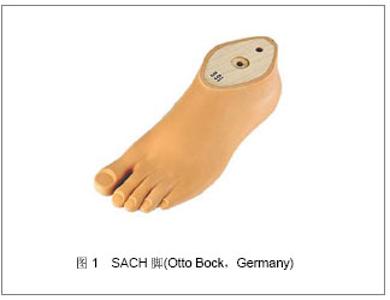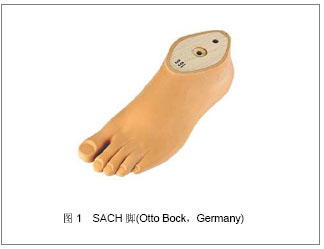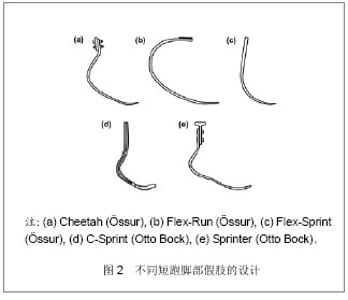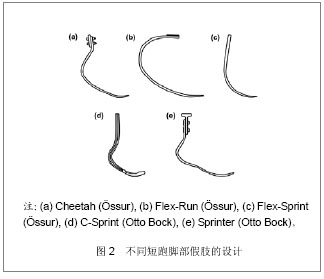Chinese Journal of Tissue Engineering Research ›› 2013, Vol. 17 ›› Issue (47): 8228-8234.doi: 10.3969/j.issn.2095-4344.2013.47.014
Previous Articles Next Articles
Latest progress of carbon-fiber-reinforced polymer energy-storing transtibial prostheses
Ding Guo-hua
- Shanghai University of Engineering Science, Shanghai 201620, China
-
Revised:2013-08-17Online:2013-11-19Published:2013-11-19 -
About author:Ding Guo-hua☆, Studying for doctorate, Lecturer, Shanghai University of Engineering Science, Shanghai 201620, China 1045214181@qq.com
CLC Number:
Cite this article
Ding Guo-hua. Latest progress of carbon-fiber-reinforced polymer energy-storing transtibial prostheses[J]. Chinese Journal of Tissue Engineering Research, 2013, 17(47): 8228-8234.
share this article

2.1 碳纤维增强复合材料特性 碳纤维增强复合材料(carbon fiber reinforced polymer/plastic,CFRP)是以碳纤维或石墨纤维或其制品为增强体的聚合物基复合材料[6],具有质量轻、比模量高、强度高、热稳定性好等优异特点[7],它包括碳纤维增强树脂(CFRP)、碳纤维增强碳、碳纤维增强金属(CFRM)、碳纤维增强水泥(CFRC)等,广泛应用于电子、汽车、飞机、原子能、化学、石油工业、机械、宇航、运动器材、医疗等行业。 在假肢中,碳素纤维增强聚合物基复合材料是将碳纤维束编组成碳布,可以用作接受腔的增强材料,制成很薄且质量很轻的接受腔[8];另一项重要应用是与树脂混渗在高温、高压下,通过模具压塑成型,碳素纤维增强树脂,用普鲁特鲁森方法合成,用于制作假肢的支撑构件或支撑管[9];碳素纤维增强聚合物基复合材料制作C-leg(运动性小腿假肢)的功能部件,代表了当代假肢技术的先进水平[10]。 2.2 碳纤维增强复合材料储能小腿假肢的应用机制 小腿假肢通常由假脚、踝关节、小腿部、接受腔及悬吊装置构成,而假脚和踝关节是小腿假肢的基本部件,对实现代偿功能起着至关重要的作用。因此,本文中讨论的小腿假肢主要是假脚和踝关节也称踝足机构[11]。 运动中,着地、站立末期和预摆动期将能量返回到人体。能量返还得越少,就越容易感到疲劳。对健康人来说,这一过程是通过胫骨肌肉群和小腿三头肌来完成的。而人类的踝关节是所有下肢关节中做功最多的,有研究发现,当以2.8 m/s的速度奔跑时,正常人类脚的能量效率达到241%,能量的储存和释放主要来自跟腱、足弓和积极的跖屈[12]。不幸的是,由于截肢手术,使得残疾人的这些肌肉(群)和关节丧失了功能,因此由假肢来提供能量转换就变得很重要。 美国的Seattle假肢研究分析中心首先提出了储能脚的概念。所谓储能假脚是指在行走中,假脚释放的能量与吸收的能量之比可达50%-95%的假脚,而传统假脚只能达20%-35%。为了适应截肢者的运动需要,这种假肢使用了特殊弹性材料作为脚芯或称“龙骨”,在运动时就能对人有一个助力,部分地代偿了截肢者所失去的腿部肌肉的功能[11]。 储能脚(energy storing foot,ESF) 的内部含有弹性储能元件,它的特点是脚在立脚相的中期(Mid-Stance) 储存身体施加在踝关节处的能量,而在最佳时刻,即推离期(Push-off) 释放出所储存的能量,以辅助推动身体向前运动。典型的储能脚产品有德国奥托搏克公司的Dynamic Pro 和Hanger Quantum [13],美国College Park Industries Inc.公司的多轴动态响应脚(Multiaxial Dynamic Response Foot ) TruSetpTM等[14]。荷兰的Postema 等[13]曾将储能脚与普通假脚的性能进行了比较,他们采用双盲随机试验法,利用英国牛津仪表公司(Oxford Metrics Ltd.) 的VICON 三维运动和图像分析系统测量并记录了被测对象的步速,步频,髋、膝、踝关节运动范围,立脚相初期的跖屈,立脚相后期的背屈,以及能量的储存、释放和消耗等运动学、动力学参数,结果表明,储能脚总的来说比普通假脚要好,特别是能量消耗比普通假脚小。 20世纪50年代,SACH脚(Ohio WillowWood,见图1)发明以来,设计和材料没有多大的改变,直到“Cheetah(印度豹)”脚的发明者范•菲利普发现,碳纤维不仅又轻又坚韧,而且最重要的是,碳纤维是各向异性的,这使得碳纤维极富弹性,可以根据水平、竖直方向上的受力不同而改变。这就使得用碳纤维做成的假肢足以返回运动员所需要的能量。也有研究表明,在能量的消耗方面,与穿戴一般假肢的人相比,碳纤维增强聚合物基复合材料的假肢确实能够产生较低的心率和需要较少的氧气供应[15]。而且,在奔跑时心率(HR)和最大吸氧量峰值水平(peak VO2)方面,与同年龄、训练水平相当和身体成分吻合的正常人心率(182.0±2.5)次/min和最大吸氧量峰值水平(55.0± 8.7) mL/(kg·min)相比,穿戴碳纤维增强复合材料假肢的运动员没有明显差距,心率(186.0±3.5)次/min) 和最大吸氧量峰值水平(50.7±9.1) mL/(kg·min) [15],因此,碳纤维增强复合材料成为制造“储能”小腿假肢部件的最合适的材料之一。 2.3 碳纤维增强复合材料储能小腿假肢的应用现状和特点 由于碳纤维增强复合材料的这些特性,1981年首次在美国西雅图假肢公司的“Seattle”脚上部分使用,而首个完全采用碳纤维增强复合材料的下肢假体-FLEX脚-由Philips在1985年发明,FLEX脚非常有效地提供了一种向上的助力,在其他当时的小腿假肢比如SACH脚中是没有的[16-17],见图1。不久就在1988年汉城残奥会上得以使用[18]。"


之后,为了迎合截肢者的需要,发明了不同型号系列的假脚。为了个性化的设计需要,在层压材料、纤维走向以及层厚度上都做了不同的调整,最大的特点是假肢的脚跟消失了,制造出世界上第一个短跑假肢-Cheetah(印度豹),它的前身叫“飞毛腿”,是20世纪80年代发明的。不过它是一款生活假肢,主要用于日常行走。当时,“飞毛腿”的发明人范•菲利普由于事故被截肢了,不得不佩戴假肢行走。不过那时候假肢的材料除了木头就是橡胶,使用起来总是不够方便,因此他决定自己尝试新的材料和技术来制作假肢,最终获得了成功。这种新材料就是碳素纤维,而新技术就是J形弯曲结构,因为外观看起来像英文字母J而得名。 虽然最初“飞毛腿”设计为生活假肢,但由于优异的材料和结构,使它一经问世就备受瞩目,一些人试图把它用于运动。1997年,“印度豹”由“飞毛腿”改进产生。它的形状确实与印度猎豹的后腿相似,不同于其他假肢“球”式运动原理,它只用很小的“脚尖”承重、触地,产生快速高效的能量返还,同时提供一定缓冲,保障舒适性。 2.4 不同运动项目碳纤维增强复合材料储能小腿假肢的选择 现代短跑小腿假肢的最大特点就是不再植入脚跟,因为优秀运动员只使用它们的脚尖来奔跑,这些假肢通常都包含一个带有关节的,长龙骨的设 计[18]。使用这种小腿假肢,单侧男性膝关节以下截肢者能够跑出10.97 s的成绩,比正常人世界纪录仅仅慢1 s左右。图2展示了目前的各种短跑运动员小腿假肢设计[19]。 很多人所熟知的南非截肢运动员奥斯卡•皮斯托瑞斯(Oscar Pistorius)参加比赛时使用的就是由知名假肢矫形器材公司奥索(Össur)提供的运动假肢[20],因其形如刀锋,奥斯卡本人也获得了“刀锋战士”的美誉。这款假肢就是在“印度豹”(Cheetah)的基础上,在“脚掌”和“脚跟”粘了一层耐克专用跑鞋的鞋底。"


在如今的职业赛跑和跳远赛场上,碳纤维增强复合材料小腿假肢几乎是排他性的[21]。据统计,在2008年残奥会上,共有来自146个国家的3 900名残疾运动员参加了比赛,其中90%左右的选手使用这种带有J形结构的“刀锋腿”。 在男子田径100 m T44级决赛,几乎每名运动员都用这种“刀锋腿”,且每条腿都是量身定做的。 而在2011年的国内残运会田径比赛,用J型假肢的选手却不是很多。虽然使用者寥寥,但J型假肢还是偶有现身。女子200 m T44级决赛中,浙江一队的汪霞红和北京队的汪娟都使用了J型假肢,两人因此分享了决赛前两名。 通常“刀锋腿”被分为几个不同型号,它们的区别在于碳纤维板材料厚度。由于体质量和爆发力不同,运动员选用不同型号的“刀锋腿”。比如,中国残奥田径队的汪娟体质量是60 kg,按照标准她应该使用3级的“刀锋腿”,但是汪娟爆发力特别好,3级的“刀锋腿”竟然被她踩裂了,所以最终她选用了5级的运动假肢,这个级别的假肢能够承受78 kg以上的体质量。因此,运动员在选择碳纤维增强复合材料腿的时候,不仅要考虑身高、体质量等要求,还要考虑截肢者的活动水平。 由于不同运动项目的技术要求不同,运动员在选择碳纤维增强复合材料假肢时也有很大差别。“印度豹”最适合的田径项目是100 m,200 m,400 m跑和跳远。与它不同,冰岛奥索公司的另一款运动假肢“长跑飞毛腿”(FLEX-RUN)则适合马拉松、三项全能等运动。 从运动训练和比赛的实际角度,长跑讲究耐力,需要不断进行压缩-释放的工作,能量返还的速度不必太快,效率也不必太高,而且要有更好的舒适性。针对这些要求,“长跑飞毛腿”被设计成英文字母C形,而不是J形,能量返还比“印度豹”慢一些,但是触地时能够提供更好的减震效果,对关节有更好的保护性,运动员也感到更舒服。 而短跑项目,最重要的是爆发力,需要快速的能量返还。此外,短跑时运动员身体呈前倾状。因此“印度豹”的设计也稍向前倾,适合短跑身体姿势的需求,J形结构也带来更快更高效的能量返还。不过与C形弯曲结构相比,“印度豹”在使用时感觉就不那么柔和,舒适性上略逊。 2.5 碳纤维增强复合材料储能小腿假肢的研究进展 随着步态分析和生物力学技术的发展,对碳纤维增强复合材料储能小腿假肢的研究主要集中步态分析、能量消耗以及应力分析等方面。 美国的WIlson等[22]使用惯性传感器对一名国内入选2012伦敦残奥会的女子100 m选手进行了跑步中的步态分析,这名选手是左侧下肢截肢者,新近换用了碳纤维增强复合材料假肢。研究表明,运动员假肢侧和正常肢体都有相似的步时,而且两种情况下都没有显著性差异。结论支持了先前研究的结果:在跑步和短跑的速度上运动员的两侧下肢很少有不对称的情况发生。但是,出研究者预料的是,发生这种结果可能是因为膝下截肢者仍然拥有股骨大肌肉群的原因所致,由于大肌肉群的存在,减震、储能和能量释放的过程与正常肢体非常相似。 Buckley[23]研究小组测量了Össur公司的“印度豹”脚的动力滞后作用,计算出它的能量效率大约为95%。而有报告称,先前的小腿假肢如SACH脚SEATTLE脚和FLEX脚获得的能力效率分别只有31%,52% 和 84%[24]。但是与正常人下肢的241%的能量效率比来说,碳纤维增强复合材料脚没有任何的优势。Nolan[19]综合前人的研究认为,尽管有股部肌群的补偿,在支撑阶段所产生的能量与正常人相比存在较大差距。 Hirons[25]通过对下肢假肢者的奔跑能力进行最优化之后发现,使用具有较大应力的“印度豹”脚能够提高截肢运动跑步的对称性。同时,增加跖屈时踝关节的角度可以减少髋伸肌的时长和跑步的对称性。 Ciobanu[26]为了测量短跑运动员使用的碳纤维增强复合材料脚的形状和应力对跑步能力的影响,对比了3种不同方法新设计的“印度豹”脚,一名下肢截肢者穿戴这3种脚以最大速度奔跑30 min。实验结果显示,与传统“印度豹”脚相比,标准“c”型但应力更大的前脚假肢,能够产生更大的跖屈角度较小的背屈角度,而且平均速度也较快(9.650 m/s)。而应力更大但更宽的“c”型的前脚假肢,有同样大小的跖屈角度和较大的背屈角度,平均速度也快于传统“印度豹”,达到9.651 m/s。最后,应力更大但更宽和更薄的“c”型的前脚假肢跑步平均速度是最快的(9.710 m/s),并且比传统“印度豹”产生更大的跖屈和背屈角度。作者最后认为,尽管受到多种因素的不同影响,但短跑速度与假肢的形状和应力方面有很大的相关,碳纤维增强复合材料小腿假肢是可以最优化的,但作者也指出,如果较大程度地改变假肢的应力,将带来更大能力的消耗[27]。 Zmitrewicz等[28]报道称,在单侧膝下截肢运动员进行跳远时,助跑过程中的快速跑阶段假肢侧的腿步长更大。在这个研究中,截肢者在起跑之初,速度较慢的情况下,存在非常大的步长的非对称性,因此往往会通过增加正常肢体的步长来提高奔跑速度,而此时假肢的步长却很稳定,这表明,更快的奔跑速度能够提高步长的对称性。 很多实验研究显示发现下肢也存在非对称性模型,在脚落地瞬间,残肢的膝和髋关节比正常肢体有更大的屈曲[29-30]。在支撑期,假肢的踝和残肢的膝关节的活动幅度很有限,角速度减小[24],导致假肢的跖屈时相缩短[19, 29]。在蹬离地面阶段,残肢的膝关节屈曲更大,髋关节比正常肢体侧有较少的伸展[29-31]。这种假肢更为向上的身体姿势可能是努力减少身体对截肢侧载荷的结果[30, 32]。另有报告称,当运动员跑步时,与正常肢体和正常人相比,假肢的纵向地面反作用力减少[30]、膝关节伸展时相缩短以及水平制动和助力减少[30]。由于膝关节伸肌力量减小或者减少了对残肢膝关节的依赖性或者可以说减小了肢体的本体感受性反馈,残肢承重随之减少,从而限制了膝关节的活动能力。目前对于通过训练提高膝关节伸肌力量是否能够促进假肢的向上姿势的形成还了解不多,但是即使是需要强大的膝关节伸肌力量的优秀膝下截肢跳远运动员,也存在这样的模型[32-34]。为了补偿减小的载荷,特别是残肢膝关节周围的载荷,有人研究认为,可以通过延长残肢髋关节伸展持续时相,在支撑阶段帮助维持向上的姿势[24, 30, 35]。因此,截肢运动员跑步时的非对称性不仅是由于假肢的功能造成的,而且是由于残肢膝关节为了减少载荷而减小本体感受性造成的。 2.6 小腿假肢在康复组织工程领域的应用级发展 小腿假肢制备材料很多,如聚乙烯、钛合金、超轻铝合金、木材、布料以及近两年比较流行的碳纤维复合材料等,在设计与制造下肢假肢零部件时已广泛应用,使现代假肢功能更完善、质量更轻。与之前那些材料相比,碳纤维复合材料在假肢领域的开发和应用相对较晚。但目前最有临床应用假肢。碳纤维复合材料具有比强度、比刚度高,可设计性强等特点,为实现降低假肢质量、提高假肢性能提供了较好的选择[36]。 目前世界上流行有近20种储能脚,基本上都是用碳纤维增强树脂基复合材料制作的[37]。但无论那种小腿假肢均需要从步态外观、运动学参数、动力学参数、压力等生物力学方面综合考虑,设计理念、材料应用均需与人体有良好的生物相容性。最近,一些学者和机构开始致力于一体化假肢的研发,主要是针对制造和材料方面,尚未涉及对一体化假肢的应力分 析[38]。由于一体化假肢与传统型假肢在结构上的差异,因此有必要对其进行应力分析。贾晓红等[39]认为在一体化小腿假肢设计阶段,必须确定接受腔和腿管之间的正常对线角度,并针对用于小腿截肢患者的新型一体化假肢设计中存在的对线问题,提出了一套优化设计方法,以步态对称性指数、残端界面压力和膝关节力矩3个评价指标的综合影响作为优化目标,克服了单项指标优化对线的局限性。孔梅等[40]研究了目前应用广泛的四种假肢接受腔及内衬套材料与皮肤的摩擦学特性,试验部位分别选择在小腿截肢残疾患者的残肢及正常人小腿胫骨脊外侧进行。试验前对皮肤和材料的表面形貌、材料亲水性进行了测试。摩擦学试验结果表明,法向载荷P为0.3 N和0.7 N下,由于硅橡胶具有特殊性质(含有硅油),与皮肤摩擦因数明显大于其他材料,并且在残疾人和正常人皮肤之间具有明显差异;其他3种材料均符合“材料表面越憎水、与皮肤的摩擦系数越低”的规律。 随着数字化医学的发展,计算机辅助三维设计及CAD/CAM系统在小腿假肢设计及理学研究方面得以广泛发展和应用。樊瑜波等[41]建立了基于有限元应力分析的小腿假肢生物力学评价技术平台,实现了小腿残端/接受腔3D几何建模与信息交互、三维有限元自动建模及应力分析。有限元模型的构建采用了专门针对小腿残端/接受腔结构特点的自动建模方法,通过构建档案数据库系统作为整个系统的操作平台。该技术平台可与现有的CAD/CAM系统相结合,为接受腔的个体化设计提供生物力学定量化依据。其临床应用将改善传统的设计流程,提高设计效率。同时,它也是未来构建接受腔设计专家/智能系统的基础。方丽丹等[42]以1例25岁男性小腿截肢患者为对象,采用三维坐标测量和核磁共振成像获得原始数据,利用软件MIMICS、SURFACER、SOLIDWORKS等实现了接受腔和残肢的三维重构,并根据接受腔修型模式等完成了系统装配,结果显示数字化三维模型较精确的反映了接受腔-残肢系统的几何特征。说明了这种低成本方法可用于假肢数字化设计、有限元分析和计算机辅助制造。张绍岚等[43]认为假肢接受腔作为截肢患者肢体残端和假肢之间载荷传递的惟一通道,是影响假肢适配性的重要部件。假肢接受腔的三维建模是接受腔实用性的关键,可以在测量时得到更准确的数据。建立的小腿残肢和接受腔计算机三维模型比较准确地反映了接受腔和残肢的几何特征和外部轮廓。假肢接受腔三维模型的建立有助于提高制作的成功率,从根本上改变传统依靠手工设计、测量、取型、修型等落后的生产模式。"

| [1] 龚思远,杨鹏,宋亮,等. 基于迭代学习控制智能下肢假肢研制:实现了对健肢步速的跟随[J]. 中国组织工程研究与临床康复, 2010, 14(13):2295-2298.
[2] 田万成,朱大成,潘风雨,等. 炸伤及创伤下肢残肢的假肢装配及功能康复训练[J]. 实用医药杂志,2008,25(4):396-397.
[3] 张晓玉. 现代假肢中新结构、新材料和新工艺[J].中国临床康复,2002,6(20):2989-2991.
[4] 王爱英,王维波. 小腿近端截肢部位与假肢接受腔选择问题的探讨[J]. 中国矫形外科杂志,2001,8(11):1133-1134.
[5] Gerzeli S, Torbica A, Fattore G. Cost utility analysis of knee prosthesis with complete microprocessor control (C-leg) compared with mechanical technology in trans-femoral amputees. Eur J Health Econ. 2009;10(1):47-55.
[6] 蒋翌军,袁正华.储能式复合材料运动假肢(腿和足弓)成型工艺研究[J].纤维复合材料,1997,6(2):13-16.
[7] Zhang M, Roberts C. Comparison of computational analysis with clinical measurement of stresses on below-knee residual limb in a prosthetic socket. Med Eng Phys. 2000;22(9): 607-612.
[8] 仇玉书.假肢-复合材料开发应用的新领域[J].特种纤维和复合材料,1995,12:16-18.
[9] 仇玉书.碳纤维及其织物的假肢制品[J].高科技纤维与应用,1996, 11,12:37-39.
[10] 张晓玉.现代假肢中新结构、新材料和新工艺[J].中国临床康复, 2002,6(20):2989-2991.
[11] 赵辉三.假肢与矫形器学[M].北京:华夏出版社,2010:60-65.
[12] Thompson H. Performance enhancement: Superhuman athletes. Nature. 2012;487(7407):287-289.
[13] Postema K, Hermens HJ, de Vries J, et al. Energy storage and release of prosthetic feet. Part 1: Biomechanical analysis related to user benefits. Prosthet Orthot Int. 1997;21(1): 17-27.
[14] Rouse EJ, Hargrove LJ, Peshkin MA, et al. Design and validation of a platform robot for determination of ankle impedance during ambulation. Conf Proc IEEE Eng Med Biol Soc. 2011;2011:8179-8182.
[15] Brown MB, Allison AR, Millard-Stafford ML. Running prosthesis facilitates greater speed, peak aerobic capacity, and improved exercise economy in amputee runners. Medicine & Science in Sport & Exercise. 2007;39(Suppl.): S244–245.
[16] Silver-Thorn B, Current T, Kuhse B. Preliminary investigation of residual limb plantarflexion and dorsiflexion muscle activity during treadmill walking for trans-tibial amputees. Prosthet Orthot Int. 2012;36(4):435-442. PMID:22581661
[17] Fey NP, Klute GK, Neptune RR. Optimization of prosthetic foot stiffness to reduce metabolic cost and intact knee loading during below-knee amputee walking: a theoretical study. J Biomech Eng. 2012;134(11):111005.
[18] Takahashi KZ, Stanhope SJ. Mechanical energy profiles of the combined ankle-foot system in normal gait: Insights for prosthetic designs. Gait Posture. 2013 Apr 26.
[19] Nolan L. Carbon fibre prostheses and running in amputees: a review. Foot Ankle Surg. 2008;14(3):125-129.
[20] Herr H. Exoskeletons and orthoses: classification, design challenges and future directions. J Neuroeng Rehabil. 2009 Jun 18;6:21.
[21] Pailler D, Sautreuil P, Piera JB, et al. Evolution in prostheses for sprinters with lower-limb amputation. Ann Readapt Med Phys. 2004g;47(6):374-381.
[22] Wilson JR, Asfour S, Abdelrahman KZ, et al. A new methodology to measure the running biomechanics of amputees. Prosthet Orthot Int. 2009;33(3):218-229.
[23] Buckley JG. Biomechanical adaptations of transtibial amputee sprinting in athletes using dedicated prostheses. Clin Biomech (Bristol, Avon). 2000;15(5):352-358.
[24] Czerniecki JM, Gitter A, Munro C. Joint moment and muscle power output characteristics of below knee amputees during running: the influence of energy storing prosthetic feet. J Biomech. 1991;24(1):63-75.
[25] Hirons R. Preparing our Paralympians: research and development at Ossur, UK. Interview by Sarah A. Curran. Prosthet Orthot Int. 2012 Sep;36(3):366-369.
[26] Ciobanu O. The use of CAD/CAM and rapid fabrication technologies in prosthesis and orthotics manufacturing. Rev Med Chir Soc Med Nat Iasi. 2012;116(2):642-648.
[27] Hafner BJ, Sanders JE, Czerniecki JM, et al. Transtibial energy-storage-and-return prosthetic devices: a review of energy concepts and a proposed nomenclature. J Rehabil Res Dev. 2002;39(1):1-11.
[28] Zmitrewicz RJ, Neptune RR, Walden JG, et al. The effect of foot and ankle prosthetic components on braking and propulsive impulses during transtibial amputee gait. Arch Phys Med Rehabil. 2006;87(10):1334-1339.
[29] Barr JB, Wutzke CJ, Threlkeld AJ. Longitudinal gait analysis of a person with a transfemoral amputation using three different prosthetic knee/foot pairs. Physiother Theory Pract. 2012;28(5):407-411.
[30] Sanderson DJ, Martin PE. Joint kinetics in unilateral below-knee amputee patients during running. Arch Phys Med Rehabil. 1996;77(12):1279-1285.
[31] Beyaert C, Grumillier C, Martinet N, et al. Compensatory mechanism involving the knee joint of the intact limb during gait in unilateral below-knee amputees. Gait Posture. 2008; 28(2):278-284.
[32] Brouwer BJ, Allard P, Labelle H. Running patterns of juveniles wearing SACH and single-axis foot components. Arch Phys Med Rehabil. 1989b;70(2):128-134.
[33] Nolan L, Patritti BL, Simpson KJ. A biomechanical analysis of the long-jump technique of elite female amputee athletes. Med Sci Sports Exerc. 2006;38(10):1829-1835.
[34] Nolan L, Lees A. The influence of lower limb amputation level on the approach in the amputee long jump. J Sports Sci. 2007; 25(4):393-401..
[35] Versluys R, Beyl P, Van Damme M, et al. Prosthetic feet: state-of-the-art review and the importance of mimicking human ankle-foot biomechanics. Disabil Rehabil Assist Technol. 2009;4(2):65-75.
[36] 崔海坡,周海风,程恩清.碳纤维复合材料特性及在假肢领域的应用[J].中国组织工程研究与临床康复,2009,13(25):4913-4915.
[37] 刘劲松,刘志泉. 现代高分子材料在假肢矫形技术领域中的应用[J].中国康复理论与实践,2004,10(10):634-635.
[38] Yeung LF, Leung AK, Zhang M, et al. Long-distance walking effects on trans-tibial amputees compensatory gait patterns and implications on prosthetic designs and training. Gait Posture. 2012;35(2):328-333.
[39] 贾晓红,李小兵,王人成,等. 一体化小腿假肢对线角度优化设计[J]. 清华大学学报-自然科学版,2007,47(5):647-650.
[40] 孔梅, 李炜,李海丽,等. 四种常用假肢材料与人体皮肤摩擦学特性的研究[J]. 生物医学工程学杂志,2008,25(5):1107-1111.
[41] 樊瑜波,蒲放,张明,等. 个体化下肢小腿假肢接受腔设计的生物力学评价技术研究[J]. 中国生物医学工程学报, 2004,23(6): 544-548.
[42] 方丽丹,贾晓红,罗勇,等. 小腿假肢接受腔-残肢生物机械系统三维重构[J]. 中国康复医学杂志,2007,22(1):55-57.
[43] 张绍岚,李古强,邵长庆,等.小腿假肢接受腔计算机三维模型的构建[J]. 中国组织工程研究与临床康复, 2010,14(48): 8954- 8957.
[44] McNealy LL, Gard SA. Effect of prosthetic ankle units on the gait of persons with bilateral trans-femoral amputations. Prosthet Orthot Int. 2008;32(1):111-126.
[45] 刘展,樊瑜波,张明,等. 壁面厚度对一体化小腿假肢应力分布的影响[J]. 生物医学工程学杂志,2004,21(4):562-565.
[46] 彭爱民,韩义连,韩庆海,等. 仿踝关节生理运动跟腱弹性牵伸器在小腿Ilizarov延长中的应用[J]. 中国矫形外科杂志,2012,20 (21): 1939-1943.
[47] Pailler D, Sautreuil P, Piera JB, et al. Evolution in prostheses for sprinters with lower-limb amputation. Ann Readapt Med Phys. 2004;47(6):374-381. |
| [1] | He Yan-ping, Ma De-chun, Li Lei, Zhang Li, Zheng Shuang, Dong Ke-xin. Hemocompatibility and surface modification of artificial blood vessel materials [J]. Chinese Journal of Tissue Engineering Research, 2015, 19(8): 1272-1276. |
| [2] | Li Bing-ting, Jia Ying-zhen, Liu Zhi-fang, Song Yuan, Hou Xiao-wei. Effect of freeze-dried bone xenograft and platelet-rich fibrin compound on osteogenesis and osseointegration of alveolar bone defects [J]. Chinese Journal of Tissue Engineering Research, 2014, 18(52): 8376-8381. |
| [3] | Wang Xiao-dong, Zhang Yong-hong. Preparation and performance of recombinant human bone morphogenetic protein-2-poly(hydroxybutyrate-co-hydroxyoctanoate) nanospheres [J]. Chinese Journal of Tissue Engineering Research, 2014, 18(52): 8405-8408. |
| [4] | Feng Chao, Li Zhe, Lv Xiang-guo, Xu Yue-min, Fu Qiang. In vitro preparation and biochemical evaluation of oxygen generative keratin/silk fibroin compound biomaterial [J]. Chinese Journal of Tissue Engineering Research, 2014, 18(52): 8480-8486. |
| [5] | Li Tian-shi, Zeng Wen-ni, He Jun-jun. Chitin and its derivatives inhibit scar formation [J]. Chinese Journal of Tissue Engineering Research, 2014, 18(52): 8504-8508. |
| [6] | Ma Song-feng, Cao Hui, Zheng Feng, Qiao Jun, Zhang Guo-ming. Concomitant cardiac valve replacement and coronary artery bypass grafting [J]. Chinese Journal of Tissue Engineering Research, 2014, 18(5): 699-704. |
| [7] | Lu Hua-ding, Lian Li-yi, Chen Ming-wei, Dai Yu-hu. Cloning and expression of Asperguillus endo-chitosanase gene in Escherichia coli [J]. Chinese Journal of Tissue Engineering Research, 2014, 18(34): 5490-5496. |
| [8] | Fan Zhong-bao, Rong Da-qing, Liu Qing-feng. Prolene hernia system versus polypropylene mesh plug in tension-free hernia repair [J]. Chinese Journal of Tissue Engineering Research, 2014, 18(34): 5535-5539. |
| [9] | Li A-li. Absorbable ligating clip in laparoscopic hysterectomy [J]. Chinese Journal of Tissue Engineering Research, 2014, 18(34): 5561-5565. |
| [10] | Lou Yan-tao. Distribution of joint isokinetic muscle strength in shot putters [J]. Chinese Journal of Tissue Engineering Research, 2014, 18(29): 4647-4652. |
| [11] | Huang Xiao-nan. Percutaneous vertebroplasty for treatment of osteoporotic vertebral fractures: high-viscosity versus low-viscosity bone cement [J]. Chinese Journal of Tissue Engineering Research, 2014, 18(16): 2461-2467. |
| [12] | Liu Li-xia, Chen Lin. Comparison of fluoride release and solubility for different glass ionomer cements [J]. Chinese Journal of Tissue Engineering Research, 2014, 18(16): 2480-2486. |
| [13] | Zhou Zheng, Yang Ze-hui, He Hui-yu, Cui Jie. Biocompatibility of freeze-dried antigen-extracted sheep cancellous bone scaffolds [J]. Chinese Journal of Tissue Engineering Research, 2014, 18(16): 2499-2505. |
| [14] | Wang Jin-ning, Pi Bin, Wang Peng, Zhu Xue-song, Yang Hui-lin. Cytocompatibility and cytotoxicity of a novel composite bone cement material composed of chitosan microsphere, alpha-tricalcium phosphate and silk fibroin [J]. Chinese Journal of Tissue Engineering Research, 2014, 18(16): 2519-2525. |
| [15] | Chen Peng, Zhang Jie, Rong Dong-ming, Han Zhong-yu, Yuan Si-jie, Tian Jing. Effects of non-dextran coated superparamagnetic iron oxide nanoparticles on proliferation of bone marrow mesenchymal stem cells [J]. Chinese Journal of Tissue Engineering Research, 2014, 18(16): 2526-2531. |
| Viewed | ||||||
|
Full text |
|
|||||
|
Abstract |
|
|||||